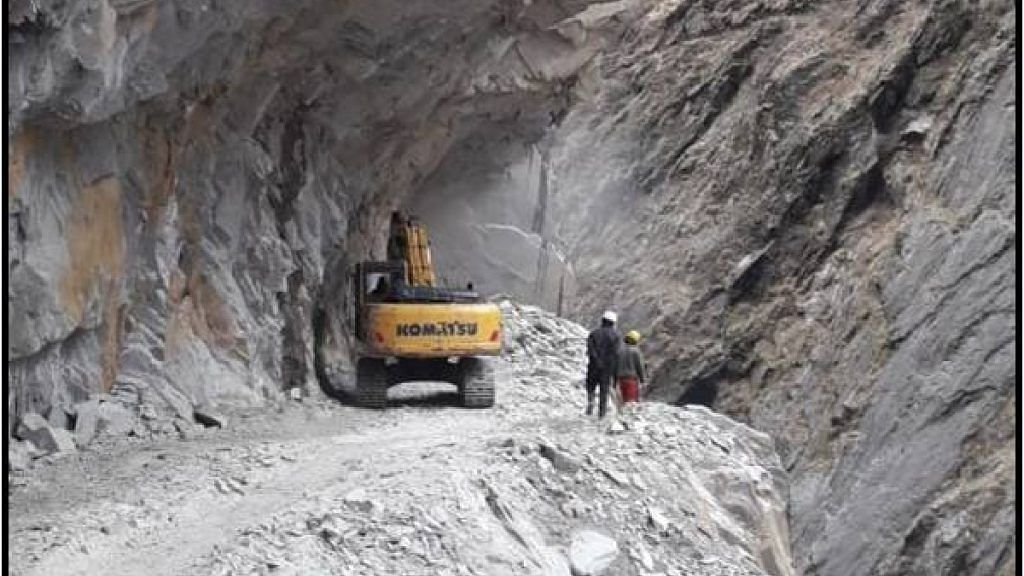New Delhi: A new and faster road route through Uttarakhand to reach Kailash Mansarovar, a pilgrimage site nestled in the Himalayas in Tibet, is complete and will soon be open to pilgrims, saving them time and an arduous trek of five days.
In a video conference, Defence Minister Rajnath Singh Friday inaugurated the road that almost goes up till Lipulekh Pass at the India-China border, 17,000 feet above the sea level. It connects the pass to Dharchula, a town in Uttarakahand’s Pithoragarh.
Singh said he was delighted to inaugurate the link road and congratulated the Border Roads Organisation (BRO), which is carrying out the project.
“The BRO achieved road connectivity from Dharchula to Lipulekh (China Border) known as Kailash-Mansarovar Yatra Route. Also flagged off a convoy of vehicles from Pithoragarh to Gunji through video conferencing,” he tweeted.
Delighted to inaugurate the Link Road to Mansarovar Yatra today. The BRO achieved road connectivity from Dharchula to Lipulekh (China Border) known as Kailash-Mansarovar Yatra Route. Also flagged off a convoy of vehicles from Pithoragarh to Gunji through video conferencing. pic.twitter.com/S8yNeansJW
— Rajnath Singh (@rajnathsingh) May 8, 2020
Highly placed sources in the government said the project is a top priority for the Narendra Modi government. The work has been particularly challenging given that it involved cutting through tough Himalayan rocks at extreme high altitudes.
“Having served in the area, I can assure you from experience that this connectivity will greatly ease the trek to the Lipulekh Pass for the pilgrims, who have had to laboriously trek the difficult stretches earlier,” Army spokesperson Colonel Aman Anand told ThePrint.
Also read: Tracing history of Ladakh’s dynamic borders — from Tibetan empire to Sikh rule to J&K state
How the road helps
Pilgrims from India can reach Kailash Mansarovar through three routes — via Sikkim, Uttarakhand and Kathmandu in Nepal — all of which are long and arduous.
The route via Uttarakhand involves three stretches. The first stretch is a 107.6 km-long road from Pithoragarh to Tawaghat, the second is from Tawaghat to Ghatiabgarh on a 19.5-km single lane, and the third stretch is the 80 kms from Ghatiabgarh to Lipulekh Pass at the China border, which can only be traversed on foot. This stretch till the India-China pass takes five days to cover.
The BRO is converting the second stretch into a double lane road, and is building a new road on the third stretch to allow vehicles. It has so far completed 76 km of the 80-km stretch, cutting travel time to just two days by a vehicle.
On crossing the International Border into China, pilgrims must walk another 5 km, followed by a road journey of 97 km and the final 43 km-parikrama around Mount Kailash.
“The last 4-5 km to the border can be trekked till it is completed,” a defence source said.
One can also travel 130 km by road from Pithoragarh to Ghatiabgarh, from where they have to cover the 80 km stretch to Lipulekh Pass.
The new road makes this route the shortest and the least expensive way to reach Mount Kailash as it is just a fifth of the distance when compared to other routes, sources said.
They added that this also ensure that the majority of the travel is in India (84 per cent) as compared to other routes where 80 per cent of the road travel is through China.
Also read: There is no hatred here: Rahul Gandhi once tweeted from Kailash Mansarovar
Pending construction
The last 4 km of road till Lipulekh Pass is expected to be completed by year end, a second source said.
Construction was on hold as the Director General of Military Operations in 2016 had placed a temporary ban on last-mile connectivity, which is yet to be lifted.
“If approved, work on last-mile connectivity to Lipulekh Pass will commence by mid-May after snow clearance, and will be completed by this year only,” the source said.
However, this will be challenging as the elevation of Lipulekh is nearly 17,000 ft above sea level, and low temperature and harsh weather will make working conditions difficult.
The Ghatiabgarh-Lipulekh road was first approved by the Cabinet Committee on Security (CCS) in 2005 at a cost of Rs 80.76 crores. In 2018, the CCS approved a revised cost of Rs 439.4 crores, with December 2022 set as the deadline.
The construction has progressed slowly because of the high altitude terrain, steep mountains having hard rock content, extreme temperatures and limited working season.
“The construction work at such altitudes could not be undertaken during winters due to heavy snow and monsoons which are accompanied by cloud bursts and frequent landslides,” the second source said.
However, in the last two years, work had gathered pace and even IAF choppers were pressed into service to lift heavy construction equipment.
Travel to Kailash
The Kailash-Mansarovar road alignment is along the Kali river, which is the boundary between India and Nepal.
The end point of road is at Lipulekh Pass, a tri-junction of India, China and Nepal.
“On the route, Gunji, which is at an altitude of 10,500 feet with ample flat area, will be the first acclimatisation area for pilgrims. The next acclimatisation can be at Nabidhang, just short of Lipulekh Pass,” the second source said.
To access Kailash through Sikkim, China and India opened the Nathu La border point in 2015. Through here, pilgrims travel by bus from the border without the ordeal of trekking and travelling on horse back.
Thousands of pilgrims in various batches undergo the Kailash Mansarovar yatra through different routes. The yatra is organised by the Ministry of External Affairs and the journey beyond the International Border is overseen by Chinese authorities.
Also read: Why exactly is Rahul Gandhi going on Mansarovar yatra at peak of Madhya Pradesh campaign?
